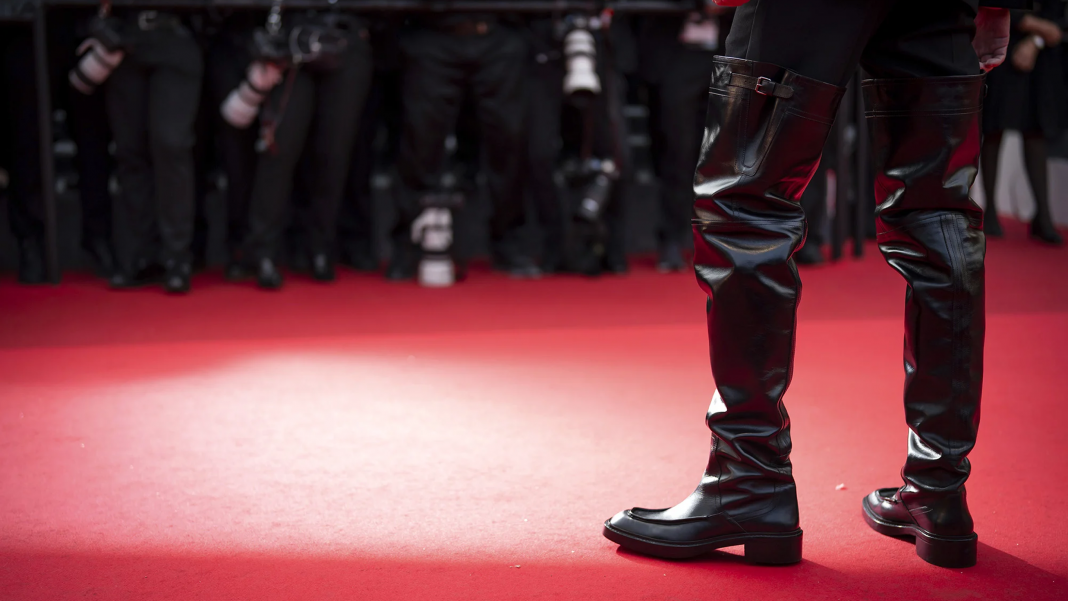At the recent Cannes Film Festival, amidst the familiar glamour of sweeping gowns and red carpet drama, Swedish actor Alexander Skarsgård made a bold sartorial statement that challenged traditional gender norms. Instead of a classic tuxedo or suit, Skarsgård stepped onto La Croisette wearing an astonishing pair of thigh-high leather boots — a style long associated with female sex appeal. Styled by Harry Lambert and sourced directly from Saint Laurent’s Fall-Winter 2025 runway, the boots completely engulfed his legs, stopping just where boxer shorts might begin. This daring fashion choice flipped expectations and invited a fresh conversation: What if Brad Pitt had worn thigh-high boots in Mr. and Mrs. Smith?

Rewriting fashion history
For decades, tall leather boots, especially thigh-high styles, have been a powerful visual shorthand for female sexuality and empowerment on screen and in fashion. Think Angelina Jolie’s iconic look as Jane Smith in Mr. and Mrs. Smith (2005), where her seductive assassin character wears thigh-high boots paired with fishnets, suspenders, and a strapless PVC minidress. This imagery cemented the boots as symbols of bold femininity and allure.
Other cultural touchstones include Julia Roberts’s Vivian in Pretty Woman (1990), Jane Fonda’s racy portrayal in Barbarella during the 1960s, and Anne Hathaway’s transformation in The Devil Wears Prada (2006). In the latter, Hathaway’s character achieves a turning point in style confidence after slipping on a pair of knee-high Chanel boots, sparking one of cinema’s most memorable exchanges when Emily Blunt’s character asks, “Are you wearing…?” only to be cut off with, “The Chanel boots? Yeah, I am.” These moments have reinforced thigh-high boots as staples of female glamour and sexiness. Yet, the story of thigh-high boots is far richer and more gender-fluid than popular culture might suggest.

A history of unisex style
Thigh-high boots didn’t start out as women’s fashion. Their roots go back to the 15th century, when men commonly wore them for practical purposes. A fascinating example surfaced in 2018 when a medieval skeleton discovered in London’s River Thames was found wearing thigh-high boots. Believed to be a fisherman, sailor, or mudlark, the boots served a functional role in keeping him dry while working in water.
During England’s Restoration period in the 17th century, these boots became a symbol of status and fashion among men, notably worn by King Charles I and his cavalrymen, known as Cavaliers. The riding-style leather boots, often with a distinguished heel, were sometimes folded down into cuffs but could be extended up to the upper thighs, combining utility with elegance.
It wasn’t until the 1960s that thigh-high boots were reimagined as feminine and sexy footwear. The groundbreaking moment came in 1962 when Cristóbal Balenciaga unveiled a knee-high boot on the Fall-Winter runway. Shortly after, shoe designer Roger Vivier pushed the design further by creating thigh-high alligator leather boots for Yves Saint Laurent’s 1963 collection. Vogue enthusiastically reported that “ankle-deep, knee-high, and even up to the thigh” boots would be everywhere, heralding a new fashion moment. This was part of the post-war cultural shift dubbed the “Youthquake,” marked by shorter hemlines, rising sexual liberation, and a bold new sense of style. Mary Quant’s invention of the miniskirt demanded complementary footwear, and tall boots became the perfect frame to showcase the now-exposed leg.
Reimagining thigh-highs for men today
While thigh-high boots have become a ubiquitous part of women’s fashion wardrobes, the male leg remains relatively unexplored terrain in this context. Alexander Skarsgård’s daring choice at Cannes signifies a growing trend of men embracing styles traditionally coded as feminine or taboo. Skarsgård’s boots from Saint Laurent’s Fall-Winter 2025 collection were styled by Harry Lambert, known for his avant-garde approach and collaborations with boundary-pushing artists. The square-toe silhouette, extreme length, and glossy leather evoke a mix of dominatrix aesthetics and fishing waders — challenging viewers to reconsider the associations we have with thigh-high footwear.
This wasn’t an isolated incident. Actor Pedro Pascal donned the same Saint Laurent thigh-high boots earlier in the year, signaling a broader acceptance among high-profile men. Beyond Saint Laurent, avant-garde menswear labels such as Rick Owens, Martine Rose, Givenchy, Maison Margiela, and GmbH have all presented their own iterations of thigh-high boots, embracing theatricality, fluidity, and experimentation.
As the boundaries of men’s fashion continue to expand, what was once considered radical becomes a logical extension of style evolution. Alongside other daring choices from ballet flats and Mary Janes to traditionally feminine silhouettes — thigh-high boots are emerging as an exciting next frontier for gentlemen who refuse to be boxed in.
The cultural impact and future of thigh-high boots
Alexander Skarsgård’s appearance in thigh-high boots on one of the world’s most prestigious red carpets is more than a style statement. It’s a cultural moment that challenges rigid gender norms and opens dialogue about how fashion can reflect identity, power, and playfulness.
The thigh-high boot’s journey from medieval practicality to modern sex symbol, and now to unisex fashion frontier, illustrates how clothing can transcend its origins to become a vehicle for social change. By flipping the script on this traditionally female-coded footwear, Skarsgård and others are helping to rewrite the rules of masculinity and self-expression.
In an era where fashion is increasingly about fluidity and breaking barriers, we can expect to see more men confidently stepping into styles once considered exclusively feminine with thigh-high boots leading the charge. As designers continue to explore this intersection of heritage, craft and bold reinvention, the thigh-high boot is poised to become an enduring icon of modern style for all genders.



